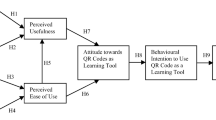Abstract
The Quick Response System (QRS) consists of a 2-D machine- readable QR Codes and a mobile-friendly user interface. The QR Codes can be encoded to different types of information. Because of QR code’s high information density and robustness, it has gained popularity in many applications across various industries. Recently, some universities and colleges have adopted QR Code into classroom teaching, by taking advantage of its instant feedback from students, instructors may have immediate understanding of whether students have understood a concept. The QR code can be used for polling, tutorials, and quizzes. However, it is crucial to protect against personal data from disclosure and to prove student identity, especially in the event of an in-class QR Code-based quiz. In this paper, we explore some potential security breaches and privacy concerns for QR codes in classroom teaching, and propose some design requirements with respect to the QR code itself. We also suggest to apply a grouping-proof protocol to authenticate all students identity before starting a quiz. This paper sheds some lights on future research directions in QR code design and processing.
Access this chapter
Tax calculation will be finalised at checkout
Purchases are for personal use only
Similar content being viewed by others
Notes
- 1.
http://www.paycash.eu/, accessed at: 08/15/2016.
- 2.
https://www.thelevelup.com/, accessed at: 08/15/2016.
- 3.
http://go4q.mobi/, accessed at: 08/15/2016.
References
Vidas, T., Owusu, E., Wang, S., Zeng, C., Cranor, L.F., Christin, N.: QRishing: the susceptibility of smartphone users to QR code phishing attacks. In: Adams, A.A., Brenner, M., Smith, M. (eds.) FC 2013. LNCS, vol. 7862, pp. 52–69. Springer, Heidelberg (2013). doi:10.1007/978-3-642-41320-9_4
Security attacks via malicious QR codes. https://goo.gl/WYO9lr. Accessed 15 Aug 2016
Moth, D.: PayPal trials QR code shop in Singapore subway (2012). http://goo.gl/qjalQQ. Accessed 15 Aug 2016
Zhuang, Y., Hancke, G.P., Wong, D.S.: How to demonstrate our presence without disclosing identity? evidence from a grouping-proof protocol. In: Kim, H., Choi, D. (eds.) WISA 2015. LNCS, vol. 9503, pp. 423–435. Springer, Heidelberg (2016). doi:10.1007/978-3-319-31875-2_35
Kieseberg, P., Leithner, M., Mulazzani, M., Munroe, L., Schrittwieser, S., Sinha, M., Weippl, E.: QR Code Security. In: Proceedings of the 8th International Conference on Advances in Mobile Computing and Multimedia, pp. 430–435 (2010)
Borgaonkar, M.: Dirty use of USSD codes in cellular network. http://www.youtube.com/watch?v=Q2–0B04HPhs. Accessed 15 Aug 2016
Wagenseil, P.: Anti-Anonymous hacker threatens to expose them. http://www.nbcnews.com/id/46716942/ns/technologyandscience-security/. Accessed 15 Aug 2016
Moore, T., Edelman, B.: Measuring the perpetrators and funders of typosquatting. In: Proceedings of the 14th International Conference on Financial Cryptography and Data Security, FC 2010, pp. 175–191 (2010)
Seeburger, J.: No cure for curiosity: linking physical and digital urban layers. In: Proceedings of the 7th Nordic Conference on Human-Computer Interaction: making sense through design, pp. 247–256. ACM (2012)
Choi, H., Zhu, B.B., Lee, H.: Detecting malicious web links and identifying their attack types. In: Proceedings of the 2nd USENIX Conference on Web Application Development, p. 11 (2011)
Zhuang, Y., Yang, A., Wong, D.S., Yang, G., Xie, Q.: A highly efficient RFID distance bounding protocol without real-time PRF evaluation. In: Lopez, J., Huang, X., Sandhu, R. (eds.) NSS 2013. LNCS, vol. 7873, pp. 451–464. Springer, Heidelberg (2013). doi:10.1007/978-3-642-38631-2_33
Acknowledgements
The work described in this paper was fully supported by the Start-Up Research Grant (RG 37/2016-2017R) of The Education University of Hong Kong and a grant from the Research Grants Council of the Hong Kong Special Administrative- Region, China (UGC/FDS11/E06/14).
Author information
Authors and Affiliations
Corresponding author
Editor information
Editors and Affiliations
Rights and permissions
Copyright information
© 2017 Springer International Publishing AG
About this paper
Cite this paper
Chen, Y., Zhuang, Y., Xie, H., Wang, F.L. (2017). On Security and Privacy of Quick Response System in Classroom Teaching. In: Wu, TT., Gennari, R., Huang, YM., Xie, H., Cao, Y. (eds) Emerging Technologies for Education. SETE 2016. Lecture Notes in Computer Science(), vol 10108. Springer, Cham. https://doi.org/10.1007/978-3-319-52836-6_63
Download citation
DOI: https://doi.org/10.1007/978-3-319-52836-6_63
Published:
Publisher Name: Springer, Cham
Print ISBN: 978-3-319-52835-9
Online ISBN: 978-3-319-52836-6
eBook Packages: Computer ScienceComputer Science (R0)




